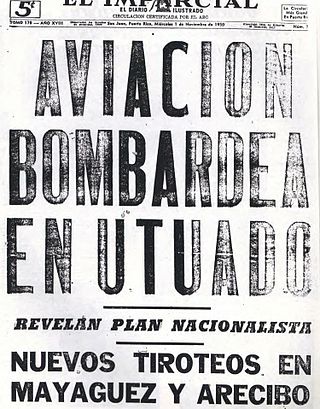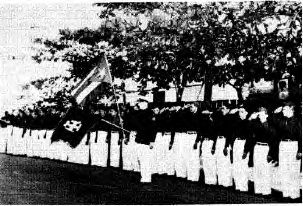
Pedro Albizu Campos was a Puerto Rican attorney and politician, and the leading figure in the Puerto Rican independence movement. He was a polyglot, as he spoke six languages. He graduated from Harvard Law School with the highest grade point average in his law class, an achievement that earned him the right to give the valedictorian speech at his graduation ceremony. However, animus towards his mixed racial heritage led to his professors delaying two of his final exams in order to keep Albizu Campos from graduating on time. During his time at Harvard University he became involved in the Irish struggle for independence.

The Ponce massacre was an event that took place on Palm Sunday, March 21, 1937, in Ponce, Puerto Rico, when a peaceful civilian march turned into a police shooting in which 19 civilians and two policemen were killed, and more than 200 civilians wounded. None of the civilians were armed and most of the dead were reportedly shot in their backs. The march had been organized by the Puerto Rican Nationalist Party to commemorate the abolition of slavery in Puerto Rico by the governing Spanish National Assembly in 1873, and to protest the U.S. government's imprisonment of the Party's leader, Pedro Albizu Campos, on sedition charges.

The Nationalist Party of Puerto Rico is a Puerto Rican political party founded on September 17, 1922, in San Juan, Puerto Rico. Its primary goal is to work for Puerto Rico's independence. The Party's selection in 1930 of Pedro Albizu Campos as its president brought a radical change to the organization and its tactics.

The Jayuya Uprising, also known as the Jayuya Revolt or El Grito de Jayuya, was a Nationalist insurrection that took place on October 30, 1950, in the town of Jayuya, Puerto Rico. The insurrection, led by Blanca Canales, was one of the multiple insurrections that occurred throughout Puerto Rico on that day against the Puerto Rican government supported by the United States. The insurrectionists were opposed to US sovereignty over Puerto Rico.

The Río Piedras massacre occurred on October 24, 1935, at the University of Puerto Rico in Río Piedras. Puerto Rico Police officers confronted and opened fire on supporters of the Puerto Rican Nationalist Party. Four Nationalist Party members were killed, and one police officer was wounded during the shooting.

The Utuado uprising, also known as the Utuado revolt or El Grito de Utuado, refers to the revolt against the United States government in Puerto Rico which occurred on October 30, 1950, in the town of Utuado. There were simultaneous revolts in various other towns in Puerto Rico, including the capital of San Juan and the cities of Mayaguez and Arecibo, plus major confrontations in the city of Ponce and the towns of Peñuelas and Jayuya.

The San Juan Nationalist revolt was one of many uprisings against United States Government rule which occurred in Puerto Rico on October 30, 1950 during the Puerto Rican Nationalist Party revolts. Amongst the uprising's main objectives were an attack on La Fortaleza, and the U.S. Federal Court House Building in Old San Juan.

The Museo de la Masacre de Ponce is a human rights museum and historic building in Ponce, Puerto Rico. It depicts the history and events surrounding the Ponce massacre, which occurred in broad daylight on Palm Sunday in 1937. The museum is housed inside the building where the event itself occurred, with one of its sections devoted to the Nationalist leader, Pedro Albizu Campos. It also documents the blacklisting of Puerto Rican Nationalists performed by the United States, as well as hosting a considerable number of photos from the Nationalist era.

Parque Urbano Dora Colón Clavell is a passive park in Ponce, Puerto Rico. The park is named after the mother of ex-governor of Puerto Rico and Ponce native, Rafael Hernández Colón. It opened on 9 December 1995. The park was designed by Ponce architect Juan Dalmau Sambolín.

Parque del Tricentenario is a passive urban park in the city of Ponce, Puerto Rico. The park was built to commemorate the 300th anniversary of the founding of the city. It was inaugurated during the mayoral administration of mayor Rafael Cordero Santiago.

Casimiro Berenguer Padilla was a Puerto Rican nationalist. He was the military instructor of the Cadets of the Republic who received permission from Ponce Mayor Tormos Diego to celebrate a parade on March 21, 1937, in commemoration of the abolition of slavery and to protest the jailing of its leaders, including Pedro Albizu Campos. The parade resulted in the police riot known as the Ponce massacre.

Isolina Rondón was a political activist. She was one of the few witnesses of the killing of four Nationalists committed by local police officers in Puerto Rico during a confrontation with the supporters of the Nationalist Party that occurred in October 24, 1935, and which is known as the Río Piedras massacre. Rondón joined the political movement and became the Treasurer of the Puerto Rican Nationalist Party which staged various uprisings in Puerto Rico against the colonial Government of the United States in 1950.

Isabel Rosado, a.k.a. Doña Isabelita, was an educator, social worker, activist and member of the Puerto Rican Nationalist Party. Influenced by the events of the Ponce massacre, Rosado became a believer of the Puerto Rican independence movement and was imprisoned because of her commitment to the cause.

Vidal Santiago Díaz was a member of the Puerto Rican Nationalist Party and served as president of the Santurce Municipal Board of officers of the party. He was also the personal barber of Nationalist leader Pedro Albizu Campos. Though not involved in the Puerto Rican Nationalist Party Revolts of the 1950s, Santiago Díaz's barbershop was attacked by forty armed police officers and U.S. National Guardsmen. The attack was historic in Puerto Rico—the first time an event of that magnitude had ever been transmitted live via radio and heard all over the island.

Raimundo Díaz Pacheco was a political activist and the Treasurer General of the Puerto Rican Nationalist Party. He was also commander-in-chief of the Cadets of the Republic, the official youth organization within the Puerto Rican Nationalist Party. This quasi-military organization was also known as the Ejército Libertador de Puerto Rico.

Cadets of the Republic, known in Spanish as Cadetes de la República, was the paramilitary wing of the Puerto Rican Nationalist Party in the twentieth century. The organization was also referred to as the Liberation Army of Puerto Rico(Ejército Libertador de Puerto Rico)

Tomás López de Victoria (1911–????) was a political activist and the Sub-Commander of the Cadets of the Republic. These cadets were the official youth organization within the Puerto Rican Nationalist Party. They were also known as the Ejército Libertador de Puerto Rico.

Elías Beauchamp was a member of the Cadets of the Republic, the paramilitary wing of the Puerto Rican Nationalist Party. Beauchamp is best known for having assassinated Col. Elisha Francis Riggs, the United States appointed chief of the Puerto Rico Police, along with fellow Cadet Hiram Rosado. Both men were arrested and shot without trial, officially while attempting to escape, at Police Headquarters in San Juan. News of the assassinations spread throughout the United States and led to legislative proposal by U.S. Senator Millard Tydings, to grant independence to Puerto Rico.

Hiram Rosado was a member of the Cadets of the Republic, the paramilitary wing of the Puerto Rican Nationalist Party who, together with fellow Cadet Elías Beauchamp, carried out the 1936 assassination of Col. Elisha Francis Riggs, the United States appointed chief of the Puerto Rico Police. Both men were arrested and shot, officially while attempting to escape, ar the police headquarters in San Juan. News of the assassinations spread throughout the United States and lead to legislative proposal by U.S. Senator Millard Tydings, to grant independence to Puerto Rico.
Pedro Albizu Campos is a statue to the memory of the Puerto Rican attorney and politician, and the leading figure in the Puerto Rican independence movement, Pedro Albizu Campos. It is at Parque Pedro Albizu Campos in Ponce, Puerto Rico, where Albizu Campos's residence used to be in the community of Tenerias, Barrio Machuelo Abajo. The statue is in bronze.













